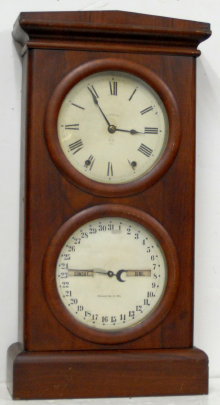
56. $500
Ithaca Calendar Clock Co. “No. 4 Hanging Office”, perpetual calendar
clock, ca 1880. The 30 day movement is signed, “Manfd For / Ithaca Cal Clock Co. / E. N. Welch / Forestville, Conn. / U.S.A. / Pat’d
Aug. 30, 1870”. Both dials look original to me, somewhat dirty and soiled, if not original they certainly have been there a long time.
Don’t forget Ithaca paper dials are easy to get and install and most collectors want their dials to look new and clean so they get
changed with each new owner. Calendar roller papers are very dark. The one thing that impresses me about this clock and I know it
is probably meaningless, is that every screw holding both dials is original. The hands appear to be correct, and the 28” walnut case
is very nice, so I must assume the wood has at least been cleaned/polished. A very good looking rare calendar clock and it ran all
the time I was researching and examining the clock. . Ly-Calendar Clocks, page 136. $750-$1000.
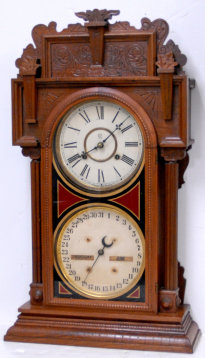
57. $550
Waterbury Clock Company “Calendar No. 43”, ca 1912. This clock
is near perfect, and to be 100 years old it is amazing. Of course some energetic soul completely refinished the case, inside and out,
had the glass repainted or bought a new one, and replaced the calendar dial. Otherwise all the pieces and parts look to be original.
The walnut case is 28” high, all original wood parts, and looks fantastic. Old signed time dial, aged of course but still very good.
The movement is 8-day, running properly and striking. The calendar movement is functioning correctly. In addition to being a calendar
clock it is a striking model. There are two labels on the back, it has the correct pendulum bob, and a winding key. This is an excellent
example of the No. 43. Ly-Waterbury #238. $750-$1000.
55. $450
Seth Thomas Clock Co., “Parlor Calendar No. 3”, ca 1876. The 8-day
upper movement is running and strikes a brass bell each hour. The lower calendar movement is functioning as intended. The dials are
original, better than most ST dials we see and are slightly faded and the calendar dial has a couple of small chips that have been
painted over. Walnut case is 27” high, all the rounded bezels are very nice but have the accumulation of years of pollutants on them.
On the inside of the door is a full black paper label. The glasses are good as are the dials, hands, and all other hardware. This
clock closely resembles the Southern Calendar Clock Fashion No. 1, cases which Seth Thomas supplied them. The two glasses are good,
key lock on the side is complete and working properly. Over the years we have sold a bushel of this model, some good, some bad, but
his one is about as good as we ever see them. Ly-Seth Thomas, page 105. $500-$750.
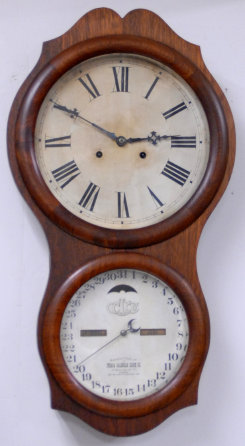
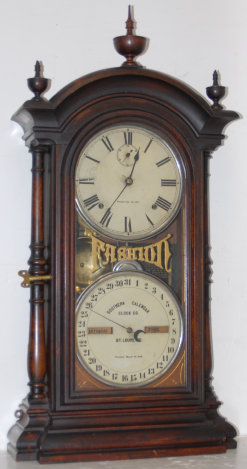
58. $1100
Southern Calendar Clock Co. “Fashion No. 3”, ca 1878. Very
similar to the No. 4 Fashion except for the pendulum bob and seconds dial. Most collectors agree that the No. 3 came with a Texas
Star pendulum and the seconds dial was flush with the time dial, whereas, the No. 4 seconds dial was recessed slightly and they had
a plain pendulum bob. This walnut case is 32” high, and is very dark with some lighter tones showing thru the smoky darkness. I doubt
it has ever been cleaned. The finials are factory type with correct marks on the base but the tips are broken off. You can have the
finials retipped or order new finials from our auction. Check in the catalog 900’s. Good gold FASHION lettering on the glass and the
gold in the incised designs on the dial board is still bright and in fact the smoke did not get inside the case so everything is clean.
The dial pans are original but I cannot swear the dial paint is original. It is old but practically every Fashion I have seen has
some paint loss on the dials, this one does not. Everything else about the clock is typical of all Fashions, 8-day movement,
hourly strike, perpetual calendar, correct star bob, original hands, and a complete black and gold label inside the case. The movements
and case were made by Seth Thomas and some of the best ever made by the clock industry. Ly-Seth Thomas, page 118. $1300-$1500.

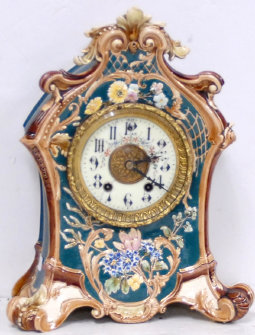
59. $400
Wm. L. Gilbert Clock Co. unusual and very rare majolica porcelain
clock, ca 1898. This clock would be very nice if it were just porcelain, but being majolica makes it very special. For those
who don’t know what majolica is I will explain. The clock case is made of damp clay then fired in a kiln. The second process is dipping
the case in a bath of fast drying liquid glaze. When dry it is hand painted and fired again. This clock is 14 inches high, all original
and has no chips, cracks, or repairs evident. The nickel 8-day movement is running and striking. The porcelain dial ring also has
painted flowers and a brass inner dial. The hands, dial, flat beveled glass and brass sash are all in excellent condition. In
fact the clock is beautiful and perfect. A few collectors would kill for this fine clock. $500-$750.
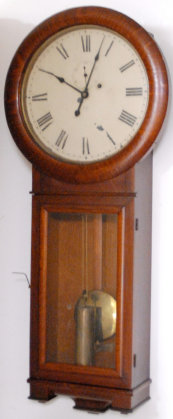
60. $600
Seth Thomas Clock Co. “Regulator No. 2”, ca a1880. Oak cased wall
regulator is 36” high, is very clean, has no veneer problems and has had no repairs. The case is very nice as it is. Maybe a little
furniture polish to keep the wood from drying. There is no problem with the bezel and that is where you normally see problems on these
rounded bezel clocks. The bezels of this type clock all have chipped veneer unless they were pampered. The dial paint has darkened
slightly and has a paint chip around the winding arbor and at 5 o’clock . The three hands look correct. Good brass pendulum
bob, wood pendulum stick, weight, pulley, beat scale, bezel, and door lock. There is a complete black label inside the case. Of course
the 8-day time only movement is also brass, very clean, and has been recently serviced and is running. Ly-Seth Thomas, pages 276-277.
$750-$1000.